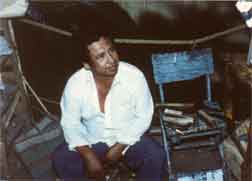
Herminio Candelario
I first met Candelario in December of 1990. My buddy
Ben Jacobson and I were driving from Madison, Wisconsin, to Colima,
Mexico to spend the holidays with my good friend Carlos and his family.
Carlos, like almost everyone else in Colima was familiar with the area's
local mask maker. After all, Candelario's family had been the local
mask makers for five generations. Also, Candelario not only makes the
masks, he leads the dances and rituals as well.
When we first met Candelario he had a badly infected
thumb that was cut deeply in a mask carving mishap a few weeks earlier.
We had a first aid kit in our van and fixed him up as best we could
with ointment and gauze. I was surprised to see him carving masks with
dull, crude knives and chisels, a manner I would have envisioned a thousand
years earlier, in pre-Columbian times.
I was taken aback by the poverty in the little Nahua
village of Suchitlán, Colima where Candelario lives. There was
one spigot in the center of the community where everyone got their water.
There was no electricity. Candelario lived in a large canvas tent with
a dirt floor, like every floor in the village.
As poor as Candelario was, the community held him in
the highest esteem as their brujo, or spiritual advisor. Brujo literally
means witch in Spanish, but in this case he was the person, or part
of the family, responsible for carving masks, making costumes, and leading
the ceremonies. Another function he served involved teaching his son
the art of mask and costume making, and the far greater responsibility
of learning the dances and rituals themselves. This involves an intricate
knowledge of the history of the culture, as well as the devotion to
keep the rituals true to their historical context and integrity. Some
of the rituals are highly intricate and detailed, with many different
dances taking place throughout the year. Candelario makes 115 different
masks, each with a special unique purpose. In return for his role in
the community, Candelario is provided with enough food and resources
to support his family.
When I met Candelario he was well known locally, but
relatively unknown on a larger scale. He was very generous with his
knowledge and allowed me to not only purchase some of his finest pieces,
but also to photograph him carving pieces. Since then, he has pieces
published in Mask Arts of Mexico. 1994. Chronicle Books, as well as
Great Masters of Mexican Folk Art from the collection of Fomento Cultural
Banamex. 2001.
Photos of Candelario taken in 1990 by Ben Jacobson

